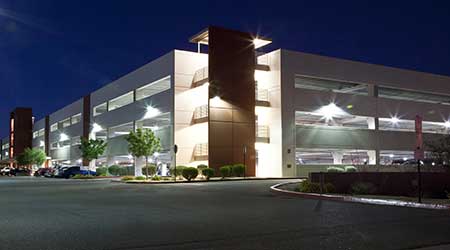How to Assess the Condition of Your Parking Structure
From criteria ranging from safety and security to aesthetics and structural stability, here is how to assess the long-term viability of your parking structures.
With contemporary designs that highlight parking structure architecture with living facades, graphic artwork, sculptural lighting, and eye-catching metal scrims, today’s parking garages merit mention in design journals and debut to architectural fanfare. As facility managers embrace the possibilities of garages’ open plan for everything from traditional parking to al fresco dining and integrated retail, the architecture of what once was the humble parking structure has become a showpiece for innovation and creativity. Investing in such inventive designs, however, means that facility managers are all the more compelled to stay on top of parking garage maintenance, which, with a structure that is exposed to the weather inside and out, can be demanding.
Whether the parking facility is a freestanding multi-level garage or a few below-grade levels under a high-rise building or plaza, the imperative is the same: proactive condition assessment and diligent maintenance. If problems are ignored, the harsh environment in garages, including corrosive deicing chemicals, freeze-thaw cycling, and the stress of thousands of vehicles traversing the deck, will quickly accelerate deterioration into hazardous conditions. With the integrity of the garage and the safety of users at stake, facility managers should prioritize parking structure evaluation and maintenance to preempt problems and avoid possible liability.
Recognizing the critical importance to public safety of parking garage stability, some jurisdictions have passed legislation requiring periodic assessment and repair of parking facilities. These regulations typically entail a comprehensive initial evaluation, followed by assessments at intervals, usually every few years. For many facility managers, these requirements codify practices similar to those already in place at their parking facilities. For others, the new laws require an unprecedented allocation of time and resources to parking garages. For facilities where maintenance has been deferred, problems may be advanced enough to require expensive and disruptive repair.
To keep from getting to that point, facility managers of parking facilities should follow a preventive approach to garage upkeep. That begins with a comprehensive assessment, typically conducted by an architect or engineer experienced in parking structure evaluation. By establishing a baseline of garage conditions, an assessment guides maintenance and repair efforts and serves as a reference point for ongoing evaluation.
The Initial Visit
Whether prompted by a government mandate, observed distress, or preventive efforts, the condition assessment process begins with an information-gathering initial visit. Reasons that initiated the assessment might include:
• Observed distress, such as spalls, cracks, corrosion, staining, or other deterioration,
• Leaks, condensation, and ponding water,
• Structural and safety concerns,
• Need for maintenance plan development, or
• Ordinance or mandate requiring garage assessments.
After establishing the history of problems, past repair efforts, previous investigations, and the original design and construction of the facility, the design professional will conduct a brief visual walkthrough of the garage. In this initial stage, the goal is to establish the type of construction and identify typical defects, as well as classify existing conditions. This information aids in determining the level and type of investigation warranted.
Existing documentation, including previous reports, construction documents, record drawings, maintenance and repair records, and manufacturer documents, are extremely useful. Having information about the original construction and past repair projects can reduce expenses by taking the guesswork out of establishing the history, condition, and underlying construction of the parking structure.
Planning the Assessment Approach
After a review of information gathered during the initial visit, an approach to assessing the parking structure will be proposed. It will be customized to the needs, age, and construction type of the facility. In general, parking garage assessments may include:
• Visual observation and photo documentation,
• On-site testing and evaluation,
• Laboratory material sampling and analysis, and
• A condition assessment report, summarizing findings.
A key part of the planning process is coordinating among trades, as parking garage investigation typically includes testing and exploratory probes that may require various subconsultants. Unless the services of contractors, testing agencies, specialists, and other parties are solicited early in the process, coordination may substantially delay the assessment. Timing of disruptive testing to avoid peak usage hours is also critical to scheduling.
The proposal should include detailed information about recommended testing, sampling, invasive probes, and analysis, with necessary subcontractors and consultants.
Visual Observation and Photo Documentation
Comprehensive visual evaluation is the cornerstone of a parking structure condition assessment. Design professionals look for conditions such as cracks, spalls, corrosion, delamination, condensation, displacement, and deterioration, but they also, perhaps more importantly, look for patterns in the observed distress.
If, for example, a precast concrete garage shows signs of water infiltration and corrosion at parking deck joints, that may suggest failure of the embedded steel connections and protective sealant, prompting invasive testing to observe concealed conditions. At a cast-in-place concrete garage, areas of widespread concrete spalling and corrosion of embedded reinforcing may indicate poor concrete cover or quality and lead to laboratory analyses to determine the concrete composition.
Identifying pervasive problematic conditions allows the assessment to be focused on problematic areas, to make best use of available resources. Indiscriminate testing in the absence of visual evidence can waste time and money. Moreover, knowing where in a many-thousand-square-foot garage to best obtain samples for analysis is critical to obtaining useful data.
Walking the entire garage is necessary to observe existing conditions, document defects and areas of distress, and identify locations for testing. Existing floor plans and elevations are helpful for noting locations of observed conditions, but if these are not available, basic drawings can be created for this purpose. Testing and sample extraction locations should be marked on the drawings for future use.
A key part of the visual evaluation is photographic documentation of observed conditions. Photographs provide a record of defects and deterioration, establishing a reference point to monitor emerging conditions. Photos also assist in identifying patterns of deterioration at sites that may be far apart yet experiencing similar distress.
Testing and Material Sampling
The type and extent of testing can vary by construction type, by the existing documentation available, and by the conditions present within a garage. If little is known about the original construction of the garage, more testing will be required to observe concealed conditions and details, and to establish a baseline for future investigations. Different types of parking structures demand different types of testing. What is appropriate for a precast concrete garage is not necessarily required or appropriate for a cast-in-place or steel-framed structure.
Precast Concrete Garages. Precast members are cast in a factory and must be moved and assembled in the field, which means that precast decks have a far greater number of joints than their cast-in-place counterparts. Each time a car traverses one of these joints, the connections undergo stress reversals from the up-and-down motion. After millions of these reversals, the welded steel connections along the joint may become fatigued, and the joint “unzips” along its length as connections fracture. As this happens at more and more connections, the structural integrity of the parking structure is compromised.
This Achilles heel makes it important to thoroughly investigate parking deck joints for signs of distress and failure.
Cast-in-Place Concrete Garages. While cast-in-place garages don’t suffer from the connection failures that can plague precast construction, they possess their own set of typical problems. Because the concrete is mixed in a plant and then transported to and cured on site, where conditions are variable, there is potential for error in creating a long-lasting and durable product. If the concrete properties are affected by transporting, placement, or finishing activities, the finished concrete may be more susceptible to cracking and chloride intrusion from deicing chemicals or freeze-thaw cycling from winter weather, leaving it prone to premature deterioration.
Prior to concrete placement, steel reinforcement must be placed on site in forms. Placement of reinforcement is critical not only to achieving the specified structural capacity of the members, but also for durability. Insufficient concrete cover can result in steel that is too close to the surface, increasing potential for corrosion from chloride-laden moisture. Corrosion can lead to expansion of the steel, delamination of the concrete, and ultimately spalling, where the surface of the concrete breaks apart.
Steel-Framed Garages. Unlike their concrete counterparts, steel-framed parking structures contain structural steel framing members (columns and beams or sometimes joists) which support concrete parking decks. These decks are either formed and cast as conventionally reinforced concrete slabs, or they are cast on galvanized metal forms or composite deck (corrugated steel). Because these decks are formed and cast on site, they are susceptible to similar quality-control issues and deterioration mechanisms as cast-in-place decks. While the metal deck components within steel-framed garages are subject to deterioration via chloride-laden moisture from above, they are also directly exposed to atmospheric moisture from humidity and condensation.
Steel is susceptible to corrosion in wet, chloride-rich environments, which are often present in coastal regions or in areas where deicing chemicals are used. Steel deck typically contains a sacrificial galvanized coating, and structural steel is coated with paints for protection. Nonetheless, these coatings can become worn or compromised over time, allowing exposure to moisture and initiation of the corrosion process. On exposed structural steel elements, this corrosion can be readily visible and evaluated. However, exposing the extent of deterioration on concealed framing or metal decking can require invasive probes.
In garages where form deck is used to support the slab, corrosion of the deck is only of aesthetic concern, as the main structural reinforcing is concealed within the slab. However, where composite deck is used, the integrity of the deck is critical, as it often serves as the slab’s main reinforcement.
Structural steel framing may be coated with fireproofing, particularly if the garage is located beneath a building. This fireproofing is critical to protecting against loss of steel strength in the event of a fire and should be visually reviewed for integrity. Locations of fireproofing failure may also highlight areas of concealed deterioration.
Concrete Composition and Quality. Subjected to the most abuse of any garage component, parking decks are generally constructed of concrete, the quality and condition of which is critical to withstanding this abuse and protecting embedded reinforcing. To evaluate resilience and potential for future deterioration, petrographic analysis and chloride testing are commonly used to identify in-situ concrete properties.
While the decks of parking structures often experience the most wear and deterioration, other structural elements, including columns, spandrels, vehicle and pedestrian guards, and stair towers, are of significant importance from a structural and life-safety perspective and warrant review during a typical assessment. Probes and testing of these elements are sometimes recommended, based on visual observations or signs of distress. Depending on the scope and need of the assessment, mechanical/electrical/plumbing systems may also be included.
What’s Included in a Condition Assessment Report
Typically, the findings of the parking garage condition assessment will include:
• A summary of the conditions prompting the investigation.
• A description of the garage construction, age, repair, and modification history (as available), and other pertinent information.
• Photographic documentation of the current condition of the parking structure, which forms the backbone of the report, with descriptive notes explaining observed construction and distress.
• A discussion of each of the reported conditions in the context of probable cause.
• Recommendations on advisable corrective action for the conditions detailed in the report. Repair strategies are generally accompanied by an opinion of probable cost, to guide planning and budgeting. The report may also provide recommended prioritization and phasing of corrective work, based on safety concerns, budget, and logistical considerations. Sometimes, a maintenance plan and schedule may be included, along with recommended frequency of inspection and upkeep activities.
How to Make Best Use of Information from a Parking Garage Assessment
Deterioration or distress that creates unsafe conditions, or that could lead to unsafe conditions, should be addressed as a matter of priority. While the condition assessment report provides useful recommendations for repair, these guidelines do not take the place of detailed project drawings and specifications, which should be prepared before repair work is initiated. The contract documents and construction administration services provide critical guidance to the contractor in carrying out the repairs, direction that can make the difference between a repair that solves the problem and one that soon fails.
The assessment also provides timelines for re-inspection, which is important to monitoring conditions that do not yet require corrective action, but which may become problematic. By routinely evaluating parking structures, building owners and facility managers can save time and resources, identifying and treating conditions before they become pervasive and require costly and disruptive remediation.
For garage users, unsightly and troubling deterioration does not make a desirable impression and can create a sense of an unsafe environment. Whether it is an innovative multi-purpose design, a sleek nod to the automobile age, a utilitarian facility, or some combination, a parking garage is only as good as its maintenance and reliability.
Related Topics:














